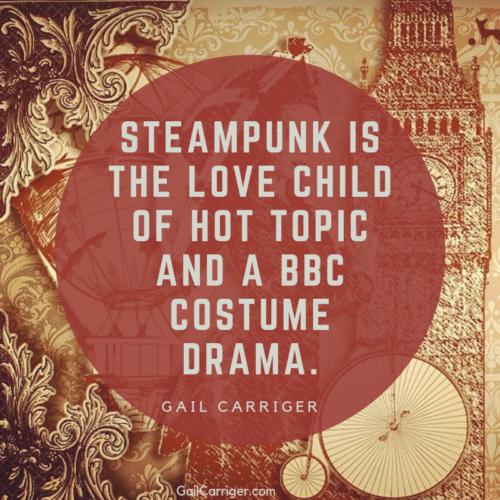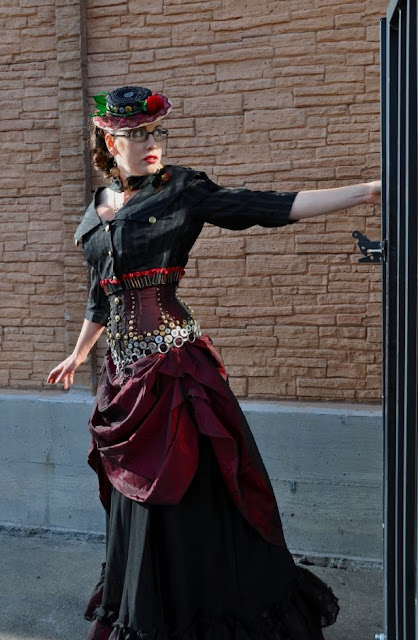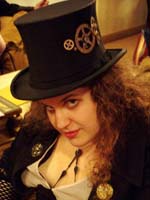The World of Steampunk: Goggles, Gaiters & Glory
To me there are two main kinds of steampunk. The first, which I shall be call, traditional steampunk, envisions a future as the Victorians imagined it. The writings of H.G. Wells and Jules Verne are good examples. The second, which I think of as industrial steampunk, sees a far future world that hearkens back to Victorian culture, for example a bustle dress made of Kevlar. There are also other temporal options like clockpunk (c. 1500s) and dieselpunk (WWII).
I write the traditional kind of steampunk, and my approach is two fold.

First, I postulate that it is through the presence of immortals that steam technology of the Victorian age diverged from our own timeline. Vampires are particularly interested in mechanics and so promote technological advancement beyond that of the actual Victorians.
Second, I try to remain true to the scientific theory of the day, however much modern scientists have debunked it. In Gail’s steampunk world the science is (at least internally) consistent, though occasionally mysterious.
 |
| by J Daniel Sawyer |
Steampunk FAQ
What is steampunk?
Steampunk is a re–imagining of either the past or the future where steam technology never died, and electricity never dominated, and a Victorian aesthetic overshadows all. Think Jules Verne and hot air balloons flying to the moon.
What’s with all the dirigibles?
I think dirigibles (and other types of airships) are particularly appealing to writers of steampunk because they quickly show the reader the alternate nature of the author’s world, and because they represent the slow majestic dignity, and slight ridiculousness, of that time period.
How did you get into steampunk?
I came to steampunk first as an aesthetic movement. I’m a longtime fan of vintage clothing and Goth style; steampunk drew me in as a cheerful melding of the two. I also love seeing recycled technology used as jewelry, and other examples of how creative the maker community has become over the past few years.

What was it that drew you to steampunk?
My Mum is a tea–swilling ex–pat. I was raised on British children’s books (Tom’s Midnight Garden, The Borrowers, The Water Babies, Wind in the Willows) and I spent many a youthful summer in Devon and two years of graduate school in the Midlands. It was this, plus the fashion aesthetic, that first drew me to steampunk – the beauty of 19th century clothing but with a less ridged everyday feel. I adore the Victorian era. I used to make hoopskirts out of my hula–hoops as a child. I also love the makers side of steampunk – technology you can see working, rather than little silver iPods with all their functionality secreted away.
What is it about steampunk that particularly excites you?
The Victorian Gothic literature movement saw the birth of science fiction. The current steampunk movement is a weird kind of full circle, taking sci–fi back to its roots ~ I love that.
Most steampunk novels are set in the Victorian era, but why did you choose that setting for yours? What’s unique about the setting in your book?
I’m comfortable writing within the Victorian Era due to my own love of Victorian literature, too many BBC costume dramas, and ten years participating in the Great Dickens Christmas Fair. The Parasol Protectorate world is unique because, unlike many other steampunk novels, it doesn’t depict a dystopian future–past but instead a cheerful lighthearted one.
Where do you see steampunk going, or where would you like it to go? How much do you think it’s going to grow as a genre?
Steampunk is a unique movement in that it isn’t entirely literary – it has ties to the green movement, the maker community, historical reenactment societies, and the fashion world. Should it crest in popularity within all of these different areas at the same time, steampunk might well rise to the forefront of world counterculture. But I don’t think that is likely. Right now, I believe it has immense escapist appeal. With our economy in chaos, steampunk offers up an alternative lifestyle of sedate civilized behavior. Do I see that lasting? Probably not, but then no one attributed urban fantasy with much staying power either, so I continue to hope.
Can you think of a non–steampunk book that could be rewritten and make a good steampunk book?
Lawrence of Arabia? No, truthfully, I’d rather see original writers and debut authors take steampunk in new and different directions. I melded my steampunk with urban fantasy and comedy of manners, how about some steampunk noir? The possibilities are endless – and so shiny and well dressed.
As one who is completely unfamiliar with steampunk, can you clarify for me which aspects of your books are considered steampunk?
My world is steampunk: an alternate 1800s England with new and different mechanicals, evil scientists, airships, docking spires, and attack automatons. The integrity of the alternative world is held together by the simple fact that I play by my own Victorian science rules (no magic). I didn’t want to overload new–to–steampunk–readers with too much gadgetry all at once. You might consider my stuff steampunk light as a result.

What exactly is steampunk fashion?
The current aesthetic movement (essentially the visual equivalent of the love child of a BBC costume drama and Hot Topic) emphasizes the importance of creativity, found object art, and the maker mentality ~ all of which I find very exciting. If you’re still curious, I did a blog post on the subject.
What one steampunk book would you recommend to readers who are unfamiliar with the genre but would like to give it a try?
I’m going to branch out and pick a graphic novel. There’s none better than the original League of Extraordinary Gentleman.

Your books feature a lot of steampunk technology, how much is based on existing technology, and how much of it is your own creation?
I’d say it’s about 50/50. I like to sneak in crazy Victorian gadgets that actually existed whenever I can, or modify them to suit my needs. Some of the technologies in my books are built out of flawed Victorian scientific theory that I made real. Some are more modern. There’s a cable transport in Blameless based off experimental US military research from the Korean War. But the rest of the time I just make things up, or go running to some of my techie or RPG friends with a plot problem that needs a steampunk solution.
I love the descriptions of all the inventions and the technology of Alexia’s world – are you a tech-savvy person? Does someone help you with that?
I’m a terrible neophyte and a very reluctant adopter of new technology. However, I am lucky enough to number many tech-savvy individuals in my life. Sometimes I create steampunk inventions from exacerbated actual Victorian gadgets, but other times I will call up one of my friends and beg them to have a conversation with me. “I need the invention to do this, but to have these limitations, and this kind of size. Any ideas? Oh and it should be funny.”
Why do you think Steampunk is appealing right now?
I have many theories on this. Part of the appeal, I think, has to do with our own sense of chaos and impending doom. This often causes people to look back and seek out time that was more ridged and controlled, full of polite manners and forms of address. Or a world that appears to have this.
What are the ingredients for a good steampunk novel?
There is a delicate balance to steampunk. You do need to do your research and know the language of the day, however, getting too flowery and Victorian can make your work inaccessible to a modern reader. It is hard to make everyone happy. There are always going to be readers who want hard science–orientated steampunk and others who can’t wade through all that techno–babble. I like to I write steampunk gateway drug. I also feel you can’t go wrong with comedy, that’s always lacking, even in the broader genres of SF/F, romance, horror, and mystery (steampunk has been classified under any of the above).
Which are the Gothic or steampunk novels that have influenced your writing?
I like the early Gothics: Castle of Otranto, The Mysteries of Udolpho, The Monk, and later, of course, Austen’s lovely parody in Northanger Abby. I can take or leave most of the romantics although I’ll borrow their archetypes and mock them openly on a whim. Many of the Victorian classic Gothics annoy me, although I do love Jane Eyre and Poe (particularly Fall of the House of Usher). I tend to prefer to read lighter fair from that time period. Later on, Wilde’s Picture of Dorian Gray is deliciously creepy, but in the end I would say I’m more influenced by his playbill humor. I suspect this is because I write spoofs and not actual Gothic literature. As for steampunk, I do borrow from Wells and Verne but not directly, more for atmosphere than anything else.
Which are the Gothic tropes or aesthetics you utilize in your own writing?
I only nominally dabble in the terror/horror side of things, and usually interrupt it with macabre humor whenever possible. I like the mystery and supernatural elements so they are always pretty strong. You’ll see the haunted house/Gothic architecture/castle thing pop up occasionally. Most of the action takes place at night, because of the conceits of the universe, but again I will break a description with comedy and because of Alexia’s snarky take on life things never get too dark. I do borrow character archetypes a lot mostly to turn the into caricatures I can break down later: human eve, evil eve, and innocent eve all pop up and then get messed with. I don’t use a lot of Byronic heroes, so I guess you could say my men are more modern romance archetypes of alpha/beta. Although Lord Akeldama and Biffy together share the role of mocking Byron as he actually was in real life. I also avoid both the arte of the supernatural (magic and the occult) and ideas of angels/demons/devil. I feel the steampunk element takes out these concepts and replaces them with science and pseudo–science, secret societies, and dastardly experiments.
Are there any (Gothic) novels you have read recently and would also recommend to your readers?
I always suggest the Cask of Amontillado, which I think of as Poe’s best and cleanest works.
In your non-fiction piece for Steampunk II: Steampunk Reloaded (anthology edited by Ann and Jeff VanderMeer),”Which is Mightier, the Pen or the Parasol?”, you touch briefly upon the various aspects of steampunk literature. For those yet unable to read this piece, which appears to be steampunk’s more enduring legacy: its subversion of past political/social views or its commentary on today’s modern society?
Oh, definitely its commentary on modern society. Whenever you get a combined aesthetic and literary movement with so many other aspects. One feels compelled to ask why it is being born right now, and what it may tell us about ourselves, our desires, and our feelings about the greater society around us.
How has your interest in steampunk affected the formation of your characters, what with Victorian mores and all. Speculate as to what they and their relative relationships would be like had they been born in another time, such as today?
The Victorian side of steampunk is vital to my characters and to my enjoyment of writing them. I experience gleeful joy when taking modern tropes ~ a strong urban fantasy heroine, barbaric alpha male, flamboyant San Francisco gay man ~ and making them play nice within an 1870’s British class and etiquette system. Suddenly my strong heroine has to cut more with her tongue than a knife, is worried about showing her ankles, and constantly seeks both a useful role in society and friends who value her intelligence and wit. My alpha male becomes a werewolf chaffing against the rules of polite society and proper dress. My flamboyant gay vampire borrows from both Oscar Wilde and the Scarlet Pimpernel, manipulating the threads of society over centuries, his relationships bittersweet and complex, allowing him to be more than just a gay BFF.
I genuinely feel that without the steampunk setting the characters would be less whole. They would need other ~ possibly more artificial ~ components and struggles, and frankly I don’t think I would enjoy writing them as much. I love the tension a Victorian world gives any kind of modern mind set. All my characters are struggling to balance their true natures against the pressures of society and in turn against modern sensibilities (informed, of course, my their creator who is quite definitely a creature of the contemporary world). This gives me a conflict of culture to play with and nothing is more exciting to me as a writer. It helps that the clothing back then was just so much more fabulous!
BOOK DE JOUR!
Soulless: Parasol Protectorate Book 1
PICK YOUR VENDOR!
Alexia Tarabotti is laboring under a great many social tribulations.
- First, she has no soul.
- Second, she’s a spinster whose father is both Italian and dead.
- Third, she is being rudely attacked by a vampire to whom she has not been properly introduced!
Where to go from there?
From bad to worse apparently, for Alexia accidentally kills the vampire, and the appalling Lord Maccon (loud, messy, gorgeous, and werewolf) is sent by Queen Victoria to investigate.
Find my books
Direct | Amazon | Kobo | Bookshop.org | B&N | Apple | Foyles | Angus Robertson
Here’s a printable Downloadable Checklist of ALL my books!
Did you miss my latest release?
Want more sneak peeks, free goodies, gossip, behind the scenes info?
This goes to my Chirrup members, because I love them bestest. Sign up here:
Not into newsletters? Get only new releases by following Gail on Goodreads, Amazon or BookBub!
Tags: FAQ, Steampunk, Victorian Culture, Victorian Fashion, Victorian Science





This was a very informative article. It had humour, wit and a good deal of common sense. It also gives the best thought out reason why I love steampunk. Manners, adventure, gadgets and gorgeous clothes for all.